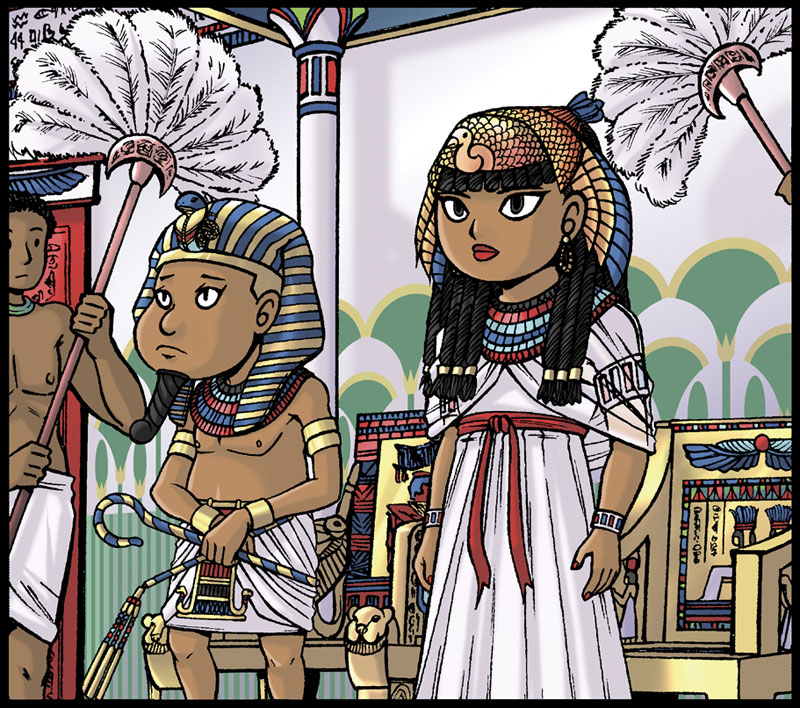
by
Damien F. Mackey
“Do you really think that Hatshepsut was Solomon's wife?
I don't think so. Hatshepsut ruled alone for many years”.
I don't think so. Hatshepsut ruled alone for many years”.
(A reader)
Introduction
The following sequence (i-v) is basically how I see the extraordinary progression of the career of Hatshepsut Maatkare, from
(i) a princess in King David’s realm, beginning in the king’s old age, through vicissitudes and desolation, and rebellion in the kingdom of Israel, to become
(ii) the Queen of Beersheba, appointed there by her maternal ‘grandfather’, Tolmai of (southern) Geshur (“Gezer”), who would succeed Amenhotep I as ruler of Egypt and Ethiopia, as Thutmose I, to her
(iii) visit and marriage to King Solomon in Jerusalem at the height of his wisdom and power, to her
(iv) subsequent marriage in Egypt to Thutmose II, whom she would succeed as
(v) woman-ruler of Egypt and Ethiopia alongside her ‘nephew’ Thutmose III.
Point (v) is perfectly in accordance with the testimony of Flavius Josephus that the Queen of Sheba who visited King Solomon was ‘the Queen of Egypt and Ethiopia’ (Ant. 8:165–173).
Since Sheba is not Egypt (though an attempt has been made to equate it with Thebes in Egypt), our heroine must have experienced the rulership of at least two separate countries.
Furthermore, Hatshepsut’s throne name, Maatkare (“Maat (the goddess of truth) is the life force of Re”), or Makera, closely resembles Makeda, the name of the biblical queen according to Ethiopian legend (Kebra Nagast).
Point (i) above encompasses her life as Abishag, the beautiful young virginal princess who served as the ageing King David’s nursemaid, and, some say, his consort-wife.
The name “Abishag” (or “Abishaug”) is, according to some views, “unknown”, and may be a Hebrew attempt to transliterate the foreign name, Hatshepsut, which Sir Alan Gardiner had rendered, “Hashepsowe” (Abishaug?).
Her Hebrew name was Tamar. She, the ‘sister’ of prince Absalom, being the unfortunate beautiful young virginal princess (again) in the care of King David, who was raped by her half-brother, Amnon, David’s oldest son.
This situation left her desolate, and forced her to live in the home of Absalom (in Shunem?) where she, unlike her fellow princesses, became “black” from working out in the sun (Song of Solomon).
The young Solomon, to whom David must have promised her, “the Shunammite”, was constantly on the lookout for her.
Point (ii) above encompasses her life when her brother, Absalom, who eventually killed Amnon, had to flee Jerusalem. He sought asylum with his maternal grandfather, Tolmai, king of southern Geshur, near Beersheba. Their mother’s name was Maacah, which name is uncannily similar to Hatshepsut’s throne name, Maa(t)kare, less the theophoric (re): hence Maacah = Maa[t]ka-
Though we are not told that Tamar fled with Absalom, it would be expected, given her complete subjection to her brother as a young woman shamed (and now with a child?).
And presumably she would have returned with Absalom to Jerusalem after King David had pardoned his son. For we find her, as Abishag, serving David during the revolt of another oldest son, Adonijah, towards the end of David’s life.
Solomon, the rightful heir to the throne of Jerusalem, will eventually slay Adonijah, who had presumed to ask for the hand of Abishag - a request which was tantamount to asking for the throne.
Such was the prestige of the young woman by now.
King Tolmai had now succeeded Amenhotep I to the throne of Egypt and he, now Thutmose I, apparently had great plans for his so-called “daughter”, Hatshepsut – though Thutmose I never actually names her as his daughter. He was the biblical “pharaoh” who will give King Solomon’s future wife the chief city of Geshur (= “Gezer”), which is Beersheba, as a dowry.
Jesus Christ gives the clearest geographical indications about the Queen of the South, at “the ends of the earth”, in other words, the south end (frontier) of the land (of Israel), the northern end being Dan (we frequently read of the full length of the land of Israel, “from Dan to Beersheba”).
In the Book of Joshua, Beersheba is called, simply, “Sheba”.
Point (iii) above includes when the Queen of the South was biding her time in the capital city (Beersheba) of the Negev desert region whilst her fiancée, Solomon, was busy building Jerusalem and the Temple of Yahweh. She could hardly wait to see what Solomon had been up to, and she was overwhelmed when she arrived in Jerusalem and saw the city/Temple in all of its magnificence.
King Solomon will set up a palatial residence for his queen whom he has married - she, his childhood friend, being his very favourite queen.
Point (iv) When Thutmose I dies, the couple undergo a diplomatic divorce (“she returned”) in order for her, as Hatshepsut, to marry Thutmose II, and so weld together the kingdoms of Egypt and Israel.
Egypt had become highly important to King Solomon as a trading partner.
It is at this point that the biblical scribes seem to lose interest in King Solomon, the mercantile king, whose trade with Egypt, and his many foreign wives, had begun to lead him into apostasy.
Point (v) above encompasses the famous queen’s virtual rulership of Egypt while Thutmose III (son of one of Thutmose II’s concubines) was still very young.
Before long she will put aside all pretence and declare herself as the first ruler of the land, duly (though bizarrely) adding a manly beard to her statues.
King Solomon will enter the land at her request and will greatly assist her as Senenmut (Senmut), her multi-tasking Steward, her quasi-royal consort, and her (you name it) – Senenmut being, according to some “the real power behind the throne”.
Eventually Solomon dies, and then, not long afterwards, Hatshepsut.
The long-suffering Thutmose III becomes free to burst upon the scene as “The Napoleon of Egypt” (Breasted).
No comments:
Post a Comment